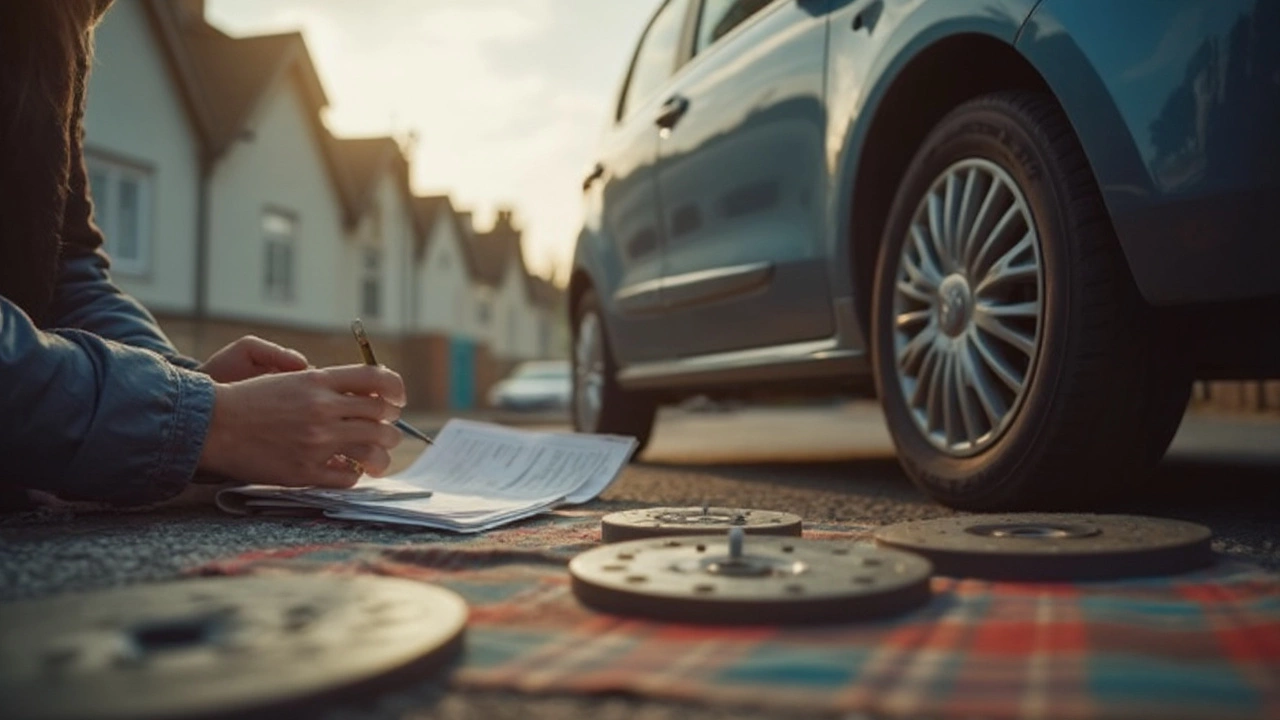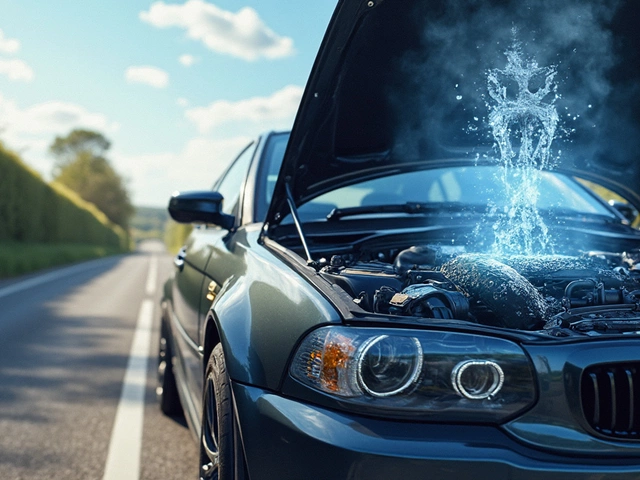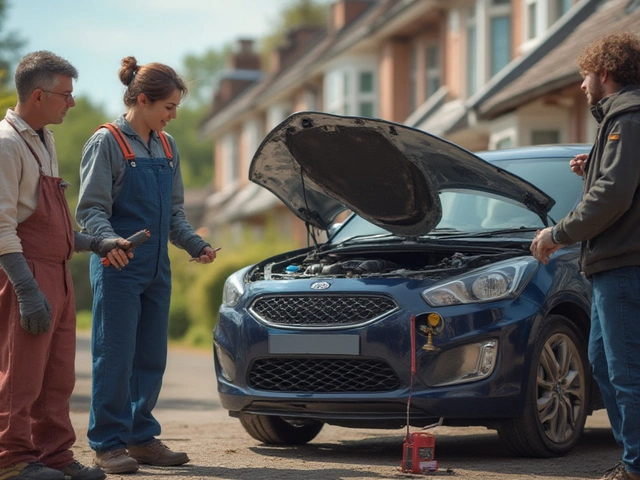Brake problems can pop up out of nowhere, and suddenly you’re at the shop staring at an estimate—replace rotors or just resurface them? Here’s the deal: resurfacing (sometimes called turning or machining) means shaving a thin layer off your current rotors to make them smooth again. Replacing means you’re swapping the old ones out for fresh metal.
But what actually works out cheaper in the long run? If your rotors aren’t worn too thin or completely warped, resurfacing almost always costs less right up front. Shops may charge anywhere from $20 to $50 per rotor to resurface, while replacement can cost $40 to $100 per rotor—and that’s just for parts. Labor hikes the price a lot more if you’re not doing it yourself.
Don’t forget: Not every rotor can be resurfaced. There’s a minimum thickness stamped on the rotor itself. Go thinner, and you’re gambling with your stopping power. Resurfacing can also be a waste if the rotors are heavily rusted or have deep grooves—that’s basically a one-way ticket to replaceville.
- What's Resurfacing? When Is It an Option?
- The Real Cost: Resurfacing vs. Replacing
- Hidden Factors That Can Change Your Decision
- Tips for Saving Money and Staying Safe
What's Resurfacing? When Is It an Option?
Resurfacing a rotor means taking off a thin layer of metal to get rid of grooves, slight warping, and surface rust. Think of it as giving your old brake rotors a fresh, flat face so the pads grab better. Usually shops use a brake lathe—the whole rotor spins while a cutting tool shaves off just enough to make it smooth again.
Here’s the thing: not all rotors can—or should—be resurfaced. Modern rotors are getting thinner as automakers chase lighter cars for better fuel efficiency. Each rotor has a minimum thickness stamped right on it; if you go below that, you risk less heat absorption and even total brake failure. The shop will measure your rotor with a micrometer before they even talk about resurfacing.
So, when does resurfacing actually make sense? These are the usual situations:
- Your rotors have mild grooves, light rust, or gentle unevenness.
- The rotor is still thick enough (check the minimum thickness mark).
- You've caught the brake problem early—no deep cracks or massive warping.
You should skip resurfacing and jump straight to replacement if:
- Your rotors are heavily scored, cracked, or have blue spots (overheated areas).
- The rotor is already close to or under the minimum thickness.
- There’s a ton of rust, especially near the center hub or vent slots.
Want some numbers to clear things up? Check the quick guide below:
| Rotor Condition | Resurface? | Replace? |
|---|---|---|
| Minor grooves, light rust | Yes | No |
| Heavy corrosion, deep scoring | No | Yes |
| Below minimum thickness | No | Yes |
| Warped, but still thick enough | Sometimes | Maybe |
If you’re driving something newer or a smaller car, chances are the rotors wear down faster and can’t be resurfaced as often as older, thicker ones. For folks who tow, drive in the mountains, or like to push the pedal hard, replacing usually makes more sense for safety. Still, if you’re only dealing with minor wear and your rotors are still beefy, resurfacing can stretch your budget further and keep you safe.
Bottom line: always ask the shop to measure your rotors and give you the numbers. Don’t just take their word for it—knowing your rotors’ actual measurements keeps your brakes real, not risky.
The Real Cost: Resurfacing vs. Replacing
Let’s talk about what you’ll actually pay. The price difference between resurfacing and replacing rotors is pretty clear, but there’s more going on under the hood—literally and financially.
Shops usually charge between $20 and $50 per rotor for resurfacing. If you need all four done, that could land you around $80 to $200 in just resurfacing fees. That usually doesn’t include removing and reinstalling the rotors, so keep that in mind if you’re not handy with a wrench yourself.
On the other hand, if you go for brand-new rotors, you can pay anywhere from $40 to $100 per rotor just for the part. Labor will run you another $50 to $100 per axle at most chain stores. High-end or performance cars? Those rotors can cost double or even triple. Here’s a quick breakdown so you can compare easily:
| Service | Average Cost Per Rotor (Parts) | Average Labor Per Axle | Total (2 Rotors, 1 Axle) |
|---|---|---|---|
| Resurfacing | $20–$50 | $40–$80 | $80–$180 |
| Replacement | $40–$100 | $50–$100 | $130–$300 |
Resurfacing definitely seems easier on your wallet up front. But here’s a catch you shouldn’t ignore—resurfaced rotors just don’t last as long as new ones. They’re already thinner and more prone to warping. If your car shakes when you brake, diving straight into new rotors might prevent repeat visits to the shop.
Also, many modern rotors are so thin from the start that shops won’t even offer to resurface them anymore. It’s not because they’re lazy—it’s because of safety and liability. The minimum safe thickness is marked right on your rotor, so ask the shop to show you before you commit to resurfacing.
Here’s an honest list of when resurfacing or replacing is the better move:
- Resurface rotors if: There’s minor unevenness, enough remaining thickness, and your rotors aren’t heavily rusted or cracked.
- Replace rotors if: There’s deep scoring, cracks, warping, or rotors are close to the minimum thickness.
So even though resurfacing grabs the headlines for being cheap, you have to look at the big picture. Sometimes paying more upfront saves your wallet and your nerves down the road.

Hidden Factors That Can Change Your Decision
Before you tell the mechanic to resurface or replace, some details can flip the answer on its head. The first thing you want to do is check your car’s rotor thickness. Every carmaker sets a minimum limit. Once your rotors wear past that number, it’s not safe to remove any more metal. For example, a lot of Honda rotors have a min thickness stamped right on the edge, usually listed in millimeters.
Heat is another big deal. If you tow heavy trailers or drive through mountain passes, your rotors take a beating. All that heat can lead to warped rotors or even fine cracks. Even if the surface looks fine, heat damage weakens the metal. If you notice shaking in your steering wheel or a soft brake pedal, replacement is probably the safest choice.
Also, pay attention to rust. Light surface rust isn’t a big deal and usually gets removed while resurfacing. But deep pitting or heavy flaking will just come back to haunt you. If your car sits outdoors a lot or you live somewhere with harsh winters and salt on the roads, replacements make more sense.
If you just threw on a fresh set of brake pads—especially performance ones—that’s worth thinking about. Resurfacing can leave micro-grooves that wear new pads quicker or make them noisy. Some repair shops won’t guarantee new pad life if you pair them with old rotors.
Here’s a quick breakdown of common factors and how much of an impact they have, using average costs and likelihoods:
| Factor | Replacement Impact | Typical Extra Cost |
|---|---|---|
| Rotor Thickness Below Minimum | Must Replace | $80–$250 (per axle) |
| Major Heat Warping | Strongly Recommended | $100–$300 (per axle) |
| Deep Rust/Pitting | Usually Replace | $80–$250 (per axle) |
| Installing New Pads | Recommended with Replacement | $35–$150 (pad set) |
One other thing? If you’re driving something fairly new or a high-mileage beater, some modern cars come with ultra-thin rotors right out of the factory to save weight and money. These usually can’t be resurfaced more than once, if at all. Your best move is to get a quick measurement at any brake shop—the answer can save your wallet or save your brakes.
Bottom line: Don’t decide in the dark. Check thickness, look for warping or pitting, and consider your driving habits before calling the shot on those rotors.
Tips for Saving Money and Staying Safe
If you’re trying to make your bucks go further at the repair shop, it’s all about timing and good choices. You can actually cut costs on brake work without cutting corners—if you know what to ask and pay attention to the details.
First up, always ask your shop if they’ll check the thickness of your rotors before making any decisions. Most rotors have the minimum thickness stamped on the edge—if you go below this, you lose stopping power and can warp your new brake pads early. Most rotors start at around 1 inch thick but can’t be safely used under roughly 0.9 inches, depending on your vehicle. Don’t let anyone try to resurface if there’s not enough metal left!
Another money-saver—shop around for parts yourself online. Sometimes, you can get high-quality aftermarket rotors for less than what the shop charges. Compare brands and reviews, but don’t just buy the cheapest. Brake rotors really do vary in quality, and the bargain basement stuff often leads to faster wear. Here’s how the price and lifespan can look for both options:
| Option | Avg. Cost per Rotor | Typical Lifespan (Miles) |
|---|---|---|
| Resurfaced Rotor | $25 (labor) | 10,000–15,000 |
| Economy Aftermarket Rotor | $40 | 15,000–20,000 |
| Premium Aftermarket Rotor | $70 | 30,000–50,000 |
Save money and headaches by always swapping the pads when you do anything with the rotors. Fresh pads on old rotors (or fresh rotors with worn pads) just shortens the life of both and makes weird noises almost guaranteed. It’s a classic case of "paying twice" when you could’ve done it once for less hassle.
Avoid letting your brakes wear down to metal-on-metal; that’s a wallet-buster and totally avoidable. Make a habit of checking your brakes every 10,000 miles, or at least whenever you swap your tires for winter or summer. Catching a thinning rotor early means you can resurface, not replace.
One more tip—don’t get talked into "high-performance" rotors if your daily drive is just to work and back. Stick with what your car came with unless you’re actually tracking or towing heavy loads. Big upgrades for normal use just chew up your budget for no reason.
- Always check the thickness before resurfacing.
- Buy reputable rotors online if you know what you’re getting.
- Change pads and rotors together—don’t mix old and new.
- Inspect brakes with every tire switch or every 10,000 miles.
- Skip fancy rotors if your driving is regular city and highway.






